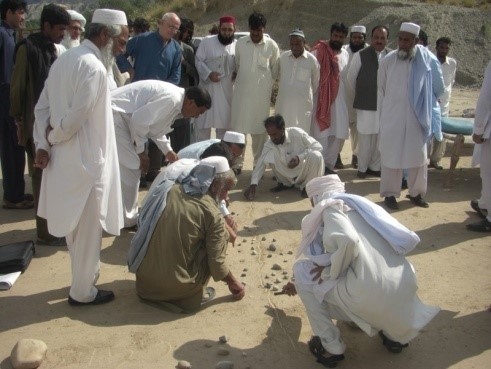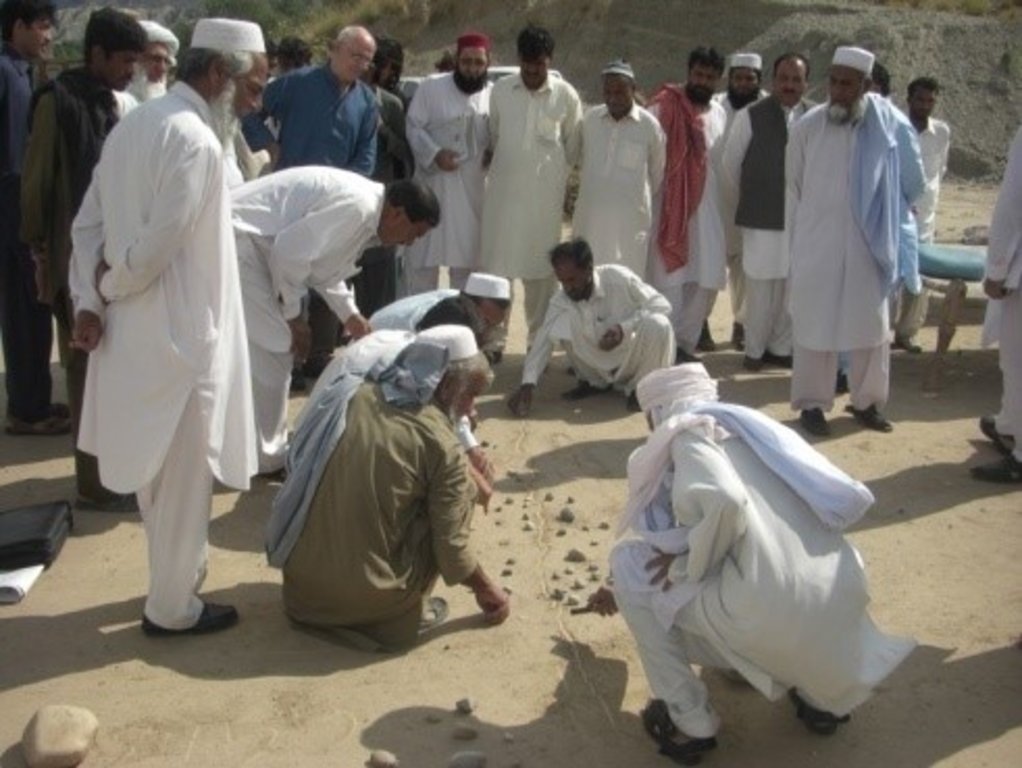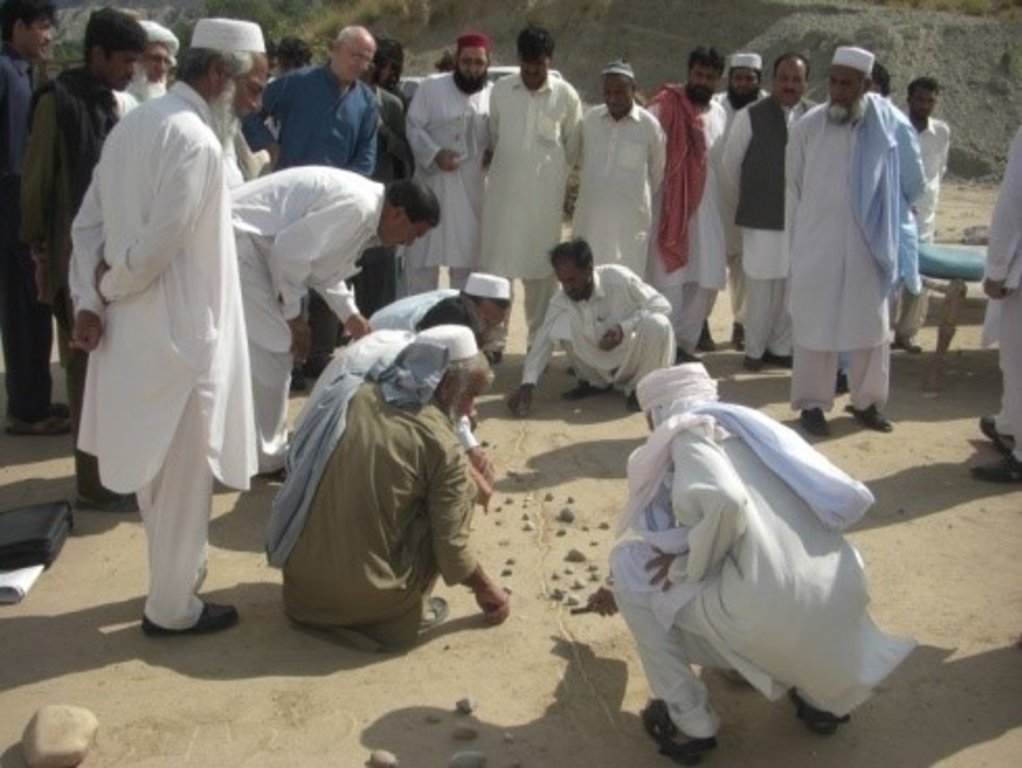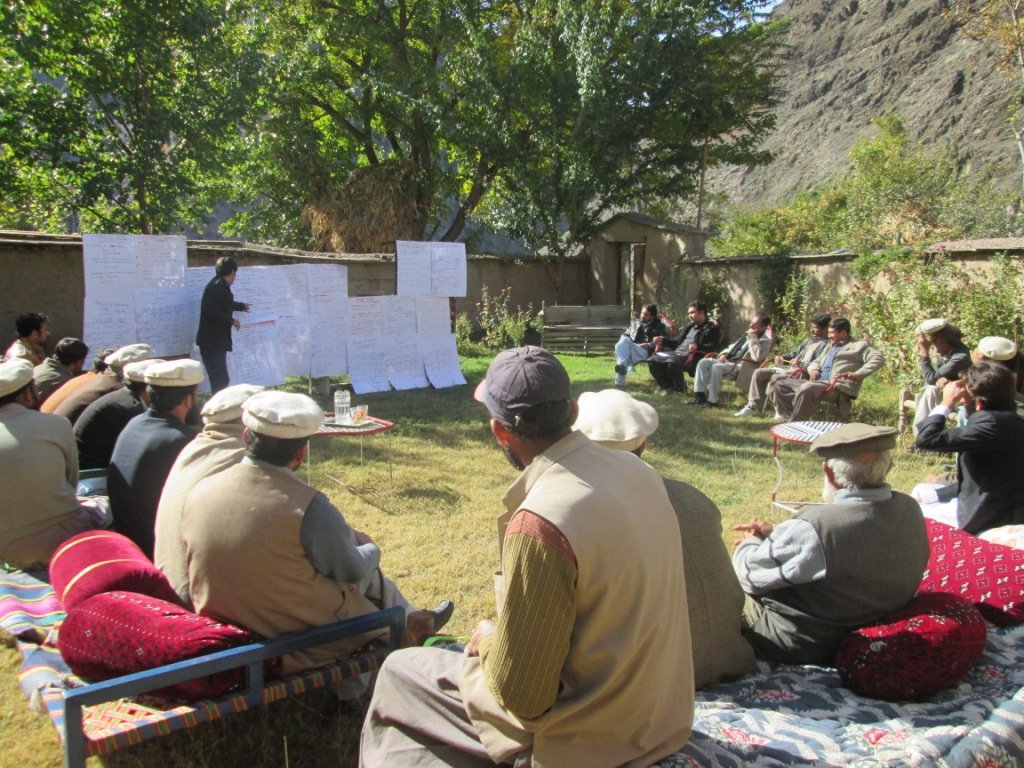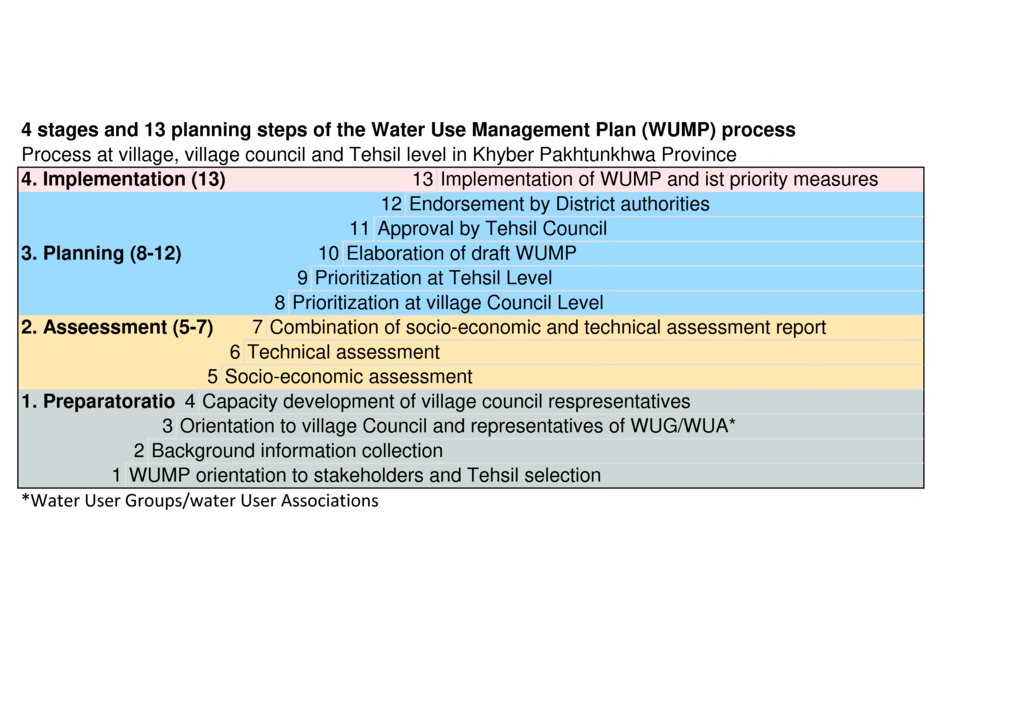Water Use Management Plan (WUMP) [巴基斯坦]
- 创建:
- 更新:
- 编制者: Eveline Studer
- 编辑者: Munawar Khan
- 审查者: Alexandra Gavilano, Nicole Harari, Hanspeter Liniger
WUMP
approaches_747 - 巴基斯坦
查看章节
全部展开 全部收起1. 一般信息
1.2 参与方法评估和文件编制的资源人员和机构的联系方式
有助于对方法进行记录/评估的项目名称(如相关)
Book project: where people and their land are safer - A Compendium of Good Practices in Disaster Risk Reduction (DRR) (where people and their land are safer)有助于对方法进行记录/评估的机构名称(如相关)
HELVETAS (Swiss Intercooperation)1.3 关于使用通过WOCAT记录的数据的条件
(现场)数据是什么时候汇编的?:
15/11/2014
编制者和关键资源人员接受有关使用通过WOCAT记录数据的条件。:
是
1.4 SLM技术问卷的参考
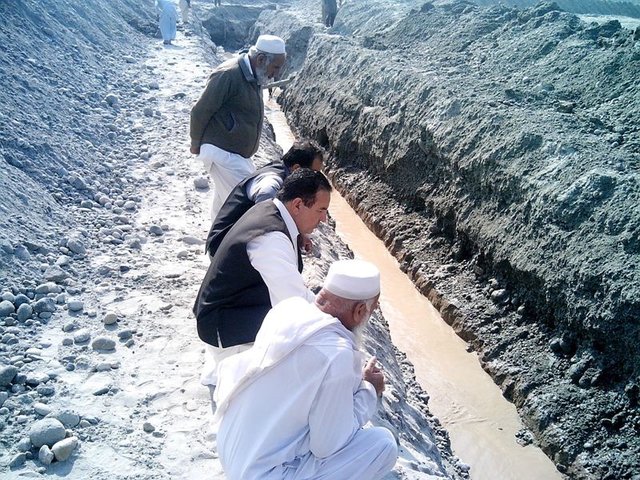
Sub-surface water harvesting for an efficient use of … [巴基斯坦]
The purpose of this water harvesting technology is to capture, collect and distribute sub-surface water. First, an infiltration gallery is developed, which allows the percolation and collection of sub-surface water through perforated pipes at a depth of approximately 3-4.5 metres. Sub-surface water is filtered by gravel/sand underground and infiltrates into …
- 编制者: Eveline Studer
2. SLM方法的描述
2.1 该方法的简要说明
The overall purpose of WUMP is to compile an inventory of available water ressources in a particular geographical or administrative area, to identify communities' priorities in order to achieve an effective, equitable and efficient use of water resources at local level. This approach promotes a participatory and inclusive analysis and implementation of measures for a sustainable management of water, land and related resources.
2.2 该方法的详细说明
该方法的详细说明:
The WUMP approach has the following specific objectives:
- to assess water available resource, existing uses and requirements
- to determine water access rights and equity issues through inclusive and interactive dialogues
- to plan and manage water resources - considering multiple needs and uses - in a participatry manner.
- to prioritise required measures, considering climate change and disaster risks
- to promote coordinated water resource development for different stakeholders
- to promote a sustainable use of water, protecting water resources and preservation of the environment
- to strengthen local institutions
- to include economically and socially disadvantaged groups
- to promote an interactive dialogue for improvement of regulatory frameworks and policies in the water sector.
The methode involves field visits by field team to collect information from the community, which is done through focus group discussion, preparation of village maps, social and technical questionnaires
The WUMP process consists of four main stages: 1) Preparation; 2) Assessment/analysis of information ; 3) Planning ; 4) Implementation (see flow chart with according sub-steps).
The process and results of a WUMP:
Is based on a participatory process, which promote inclusiveness. It fosters coordination and collaboration among different local stakeholders including government, communities and private sector and helps to establish the baseline situation and a comun understanding. Land users and other local actors appreciate this approach as it promotes a participatory, transparent process for an equitable distribution of water and a sustainable management of water related resources. The approach helps to overcome potential economic or socio-cultural barriers, by providing a comun space for joint analysis, discussion and solution finding by facilitating interaction between stakeholders of different contexts.
2.3 该方法的照片
2.5 采用该方法的国家/地区/地点
国家:
巴基斯坦
区域/州/省:
Dera Ismail Khan Thensil (sub-division), Khyber Pakhtunkhwa (province)
Map
×2.6 该方法的开始和终止日期
注明开始年份:
2014
终止年份(若不再采用该方法):
2019
注释:
The approach remains valid and applicable also after the termination of a project intervention.
2.7 方法的类型
- 基于项目/方案
2.8 该方法的主要目的/目标
The main aim of the WUMP approach is to assess the availability of water resources, existing uses/demands and future requirements/needs. The WUMP helps to address water access, equity issues and balance these rights through interactive dialogues within the community and other local stakeholders. The WUMP approach contributes therefore actively to water governance and improved management of natural resources.
2.9 推动或妨碍实施本办法所适用的技术的条件
社会/文化/宗教规范和价值观
- 启动
The approach helps to overcome potential economic or socio-cultural barriers, by providing a comun space for joint analysis, discussion and solution finding by facilitating interaction between stakeholders of different contexts.
财务资源和服务的可用性/可得性
- 启动
The implementation of the WUMP tends to increase access to water for production purposes with a positive impact for households/ communities' income.
The results of the WUMP process with its according priorities of intervention are recognized by local government and reflected in local annual development plans and according budgets.
- the WUMP defines options for other actors to investment in water sector based on communities' priorities.
机构设置
- 启动
WUMP is steered by the district Coordination Committee at district level having representative from all concerned government departments, Water User Association including women members, representatives from civil society where they adress key issues and take decisionsof the local water sector.
参与者的的协作/协调
- 启动
Collaboration among actors is the central element of the WUMP, which pomotes a coordinated water resource development involving different stakeholders: communities and government and non-governmental organizations. The process, enables local institutions to consider needs and participation of economically and socially disadvantaged groups.
法律框架(土地使用权、土地和水使用权)
- 启动
WUMP addresses and defines solutions on water access & equity issues through interactive dialogues.
政策
- 启动
WUMP can influence sector policies at local level based on the collections of baseline data and evidence, which contributes to improve frame conditions. Topics, priorities and challenges of the WUMP are addressed with stakeholders at district Coordination Committee, which can actively influence policies of the water sector.
了解SLM,获得技术支持
- 启动
The local stakeholders, namely communities are directly involved in the implementation of the WUMP, which improves their knowledge about SLM.
3. 相关利益相关者的参与和角色
3.1 该方法涉及的利益相关者及其职责
- 当地土地使用者/当地社区
Rural local communities, water & land users
Participation as an integral part in preparation at village level. Contribution to the assessment, prioritisation and implementation of the interventions
- 社区组织
Water user associations (WUA)/ water users groups (WUG)
Responsible to support and facilitate the WUMP process, social support, provision of primary information. Ensure participation and involvement of all WUA members. Coordinate with relevant authorities and other development actors to identify technical and financial support in their area / water sector.
- SLM专家/农业顾问
staff of the Water for Livelihoods Project : WUMP coordinator (engineer, male, 53 years), senior engineer (engineer, male, 43 years)
Coaching and guidance at all level, steering of WUMP process in collaboration with District Government, organize trainings as scheduled, support field teams for the collection of technical and social information/data.
- NGO
Local partner NGO
Project implementation, social mobilisation and interaction at field level to ensure that the social dimension, local concerns deserving support are adressed and that the water user association (WUA) are inclusive and gender concerns are duly represented. Support water user associations in their advocacy efforts to mobilize resources for WUMP.
- 私营部门
Consultant
Compilation of data, collected information and writing of WUMP
- 地方政府
District Authorities / Administration
Provision of legal and administrative acceptance, recognition and support to WUMP implementation. Support through provision of timely technical services to water user association /groups in WUMP implementation, validation of information (data regarding drinking water supply, irrigation, water use efficiency, soil conservation by Public Health Engineering Department, Irrigation Department, On Farm Water Management Department, Soil Conservation Department ). Participation to ensure a participatory monitoring and provide feedback to the district govt. for improvements in delivering of water sector services.
- 国家政府(规划者、决策者)
District and provincial governments
Policy dialogue counter-part to address WUMP issues, which require a change in policies, coordination and engagement with in-line authorities and to allocate resources for the integration and implementation of WUMP in the district development plan (ADP).
- 国际组织
Swiss Agency for Development and Cooperation (SDC)
Financial ressources. Partner for advocacy and policy dialogues to address key topics in the water sector in their policy dialogue with national government representatives.
如果涉及多个利益相关者,请注明领导机构:
Water for Livelihoods Project
3.2 当地土地使用者/当地社区参与该方法的不同阶段
| 当地土地使用者/当地社区的参与 | 指定参与人员并描述活动 | |
|---|---|---|
| 启动/动机 | 互动 | Community through water user association (WUA) and water user group (WUG) in their actvities: support and facilitate the WUMP, ensure that all WUGs are involved in the process, link with relevant authorities and other development actors for technical and financial support development. |
| 计划 | 互动 | Community: WUA/WUG in their activities: Participate as an integral part in the preparation of WUMP at village level. Contribute to conducting feasibility, implementation and execution of interventions. |
| 实施 | 互动 | Community: WUA/WUG in their activities: Support a system for cost contribution by the community. Link with relevant authorities and other development actors for seeking the technical and financial support in their area water sector development. Promote and advocate for sustainable development in the water sector. |
| 监测/评估 | 互动 | Community: WUA/WUG in their activities: Ensure equitable water rights and promote good water governance principles. Ensure strong linkages with WUA/community through regular meetings and documentation of decisions. |
3.3 流程图(如可用)
具体说明:
The process of WUMP is divided into 4 stages consisting of 13 steps
作者:
Syed Hussain Mustafa, Khan Muhammad, Tawheed Gul, Munawar Khan Khattak
3.4 有关SLM技术选择的决策
具体说明谁有权决定选择要实施的技术:
- 所有相关参与者,作为参与式方法的一部分
解释:
The technology is selected via mutual consensuses at village council level. This process is facilitated by a SLM specialist. Women - as well as other vulnerable and marginalized groups - are also part of the water user association and participate in the discussion and decision making process. Where joint setting of men & women is not possible due to cultural constraints, separate meetings of men & women are conducted to cover the voices and concerns of both.
明确做出决策的依据:
- 对充分记录的SLM知识进行评估(基于证据的决策)
- 个人经验和意见(无记录)
4. 技术支持、能力建设和知识管理
4.1 能力建设/培训
是否为土地使用者/其他利益相关者提供培训?:
是
明确受训人员:
- 土地使用者
- 现场工作人员/顾问
- Government department specilist (SLM)
培训形式:
- 在职
- 农民对农民
- 公开会议
涵盖的主题:
Water resources conservation, efficient use of water resources, irrigation water distribution/ scheduling.
注释:
Water Users are trained in different techniques of water conservation, such as water crop budgeting, local flow measuring techniques, irrigation scheduling with regard to specific crops.
The users are specifically trained in techniques for efficient water use, such as furrow irrigation, raised bed irrigation, mulching etc.
4.2 咨询服务
土地使用者有权使用咨询服务吗?:
是
指明是否提供了咨询服务:
- 在土地使用者的土地上
- 在固定中心
说明/注释:
SLM specialist made field visits and provided technical guidance to Land Users
The Land Users visited relevant organizations for technical guidance
4.3 机构强化(组织发展)
是否通过这种方法建立或加强了机构?:
- 是,适度
具体说明机构的强化或建立程度:
- 本地
说明机构、角色和职责、成员等。:
Water User Association (WUA, local Institutions) at district & sub-district level were strengthened. The legally recognize WUA and Apex of the WUA take gradually responsibilities to support and facilitate the WUMP process. The WUAs strives for improvements in the water sector and are a catalyst to bring together and pool communities, civil society organisations, local authorities and other actors of different actors for to address water issues and development options.
具体说明支持类型:
- 能力建设/培训
提供进一步细节:
Project provided trainings for 16 Water User Associations (WUAs) and 3 Apex WUAs in Chitral, Karak, and DI Khan. These 16 associations aim to improve development in the water sector, to improve water governance to contribute to resolutions in case of disputes amongst different water right holders for an equitable access to water at local and at district level.
Through these trainings, the WUGs/ WUAs members representing various groups/ associations - including representatives from Government Line Agencies are trained in community management & skill training, mediation in case of water disputes, monitoring/documentation and health/hygiene.
4.4 监测和评估
监测和评估是该方法的一部分吗?:
是
注释:
The principle of the monitoring, is to actively engage the communities associations (WUA/WUG) and capture their observations and concerns.
This is done through direct feedbacks from communities, during regular field visits and interaction with technical departments, who receive feedbacks from communities based on regular exchanges.
若是,该文件是否用于监测和评估?:
否
注释:
This documentation is not primarily used for monitoring & evaluation purpose. However it contributes to establish a baseline.
4.5 研究
研究是该方法的一部分吗?
否
5. 融资和外部物质支持
5.1 该方法中SLM组成部分的年度预算
如果不知道准确的年度预算,请给出一个范围:
- 2,000-10,000
注释(例如主要的资助来源/主要捐助者):
The cost for the preparation of WUMP depends on the size of the area
5.2 为土地使用者提供财政/物质支援
土地使用者是否获得实施该技术的财政/物质支持?:
是
如果是,请具体说明支持的类型、条件和提供者:
The project and governamental counter parts (Department) provide material and technical support. The community provides in-kind contribution through labor and local material for the imlementation of the measures/ technology.
5.3 对特定投入的补贴(包括劳动力)
如果土地使用者的劳动力是一项重要的投入,那么是不是:
- 自愿
5.4 信用
是否根据SLM活动的方法给予信用值?:
否
5.5 其它激励或手段
是否有其他激励措施或工具用于促进SLM技术的实施?:
否
6. 影响分析和结论性陈述
6.1 方法的影响
该方法是否有助于当地土地使用者,提高利益相关者的参与度?:
- 否
- 是,很少
- 是,中等
- 是,支持力度很大
The approach supports land and water users to make decisions regarding water use by their own.
这种方法是否有助于基于证据的决策?:
- 否
- 是,很少
- 是,中等
- 是,支持力度很大
The preparation stage includes an analysis, where information for evidence and later decisions is collected. Once the effectiveness of the approach is recognized, it can be replicated by other communities them-selfs.
该方法是否帮助土地使用者实施和维护SLM技术?:
- 否
- 是,很少
- 是,中等
- 是,支持力度很大
Land users are involved for the implementation and maintenance of the prioritized measures in the WUMP plan, which an efficient use water for productiion and drinking purposes.
该方法是否提高了SLM的协调性和成本效益?:
- 否
- 是,很少
- 是,中等
- 是,支持力度很大
The WUMP provides options for cost sharing mechanisms amongst different actors, to attract funding for prioritized initiatives. The prioritized initiatives of WUMP are jointly implemented by different stakeholders, which can reduce its costs.
该方法是否调动/改善了使用财务资源实施SLM的途径?:
- 否
- 是,很少
- 是,中等
- 是,支持力度很大
The results of WUMP (measures) are included in the official departmental annual development plans and budgets.
该方法是否提高了土地使用者实施土地管理的知识和能力?:
- 否
- 是,很少
- 是,中等
- 是,支持力度很大
The land and water users learnt how to analyse and assess water resources. They learnt about options to address the identified challenges.
该方法是否提高了其他利益相关者的知识和能力?:
- 否
- 是,很少
- 是,中等
- 是,支持力度很大
Similarly, all other involved stakeholders' learn how to analysse and asses water resources and know about options to address them.
该方法是否建立/加强了机构、利益相关者之间的合作?:
- 否
- 是,很少
- 是,中等
- 是,支持力度很大
By establishing a district coordination committee to steer the approach (WUMP) all stakeholders can jointly discuss, address their needs and suggest options to be prioritized.
该方法是否缓解了冲突?:
- 否
- 是,很少
- 是,中等
- 是,支持力度很大
Through this approach all stakeholders - especially the up-stream & down stream users - can resolve their water related disputes through dialogue. This contributes to resolve disputes between communities and concerned department.
该方法是否有助于社会和经济弱势群体?:
- 否
- 是,很少
- 是,中等
- 是,支持力度很大
Disadvantaged groups participate in the preparation process of the plan, where they reflect and contribute with their concerns, needs and priorities.
该方法是否改善了性别平等并赋予女性权力?:
- 否
- 是,很少
- 是,中等
- 是,支持力度很大
Same participation as the disadvantaged groups. Women are also part of the decision making body.
该方法是否鼓励年轻人/下一代土地使用者参与SLM?:
- 否
- 是,很少
- 是,中等
- 是,支持力度很大
Same participation as the disadvantaged groups. Generall people of the age group 30-45 have are the leader of associations - supported by their elders - to address and develop water ressouce management of their villages.
该方法是否改善了粮食安全/改善了营养?:
- 否
- 是,很少
- 是,中等
- 是,支持力度很大
Through the approach water efficient technologies are promoted, which allow to increase production and improve food security.
该方法是否改善了供水和卫生条件?:
- 否
- 是,很少
- 是,中等
- 是,支持力度很大
Through the approach options to improve access to water for domestic use are promoted. Access to clean drinking water at households' proximity contributes to improved sanitation.
该方法是否提高了土地使用者适应气候变化/极端情况和减轻气候相关灾害的能力?:
- 否
- 是,很少
- 是,中等
- 是,支持力度很大
The result of the WUMP approach is a set of options, where efficient use of water and water saving technologies are promoted e.g. water harvesting.
6.2 土地使用者实施SLM的主要动机
- 增加生产
WUMP aims to improve access and availability of water. More water for irrgation and efficient water use technologies contribute to increased yields. Consequently surface for agricultural production can be extended.
- 增加利润(能力),提高成本效益比
By promoting efficient water utilization techniques, this can reduce costs, especially where power driven water pumping is involved.
- 减少土地退化
Earlier in areas of water scarcity flood irrigation, which leds to erosion, was applied. This approach helps to promote more sustainble irrigation options.
- 降低灾害风险
In the initial analysis stage of WUMP different water related hazards, mainly floods and droughts, are identified. As a result options to reduce according risks are identified and promoted.
- 规章制度(罚款)/执行
This approach help in aligning the traditional rules with formal rules and regulation in water management. The associations are not only right holders but they are also duty barer to communities.
- 环境意识
The approach promotes a sustainable water resource management. It promotes conservation and balances it with an efficient use of water fo rdifferent purposes. At the assessment stage potential problems related to unsustainable practices are analized and addressed.
- 提高SLM知识和技能
Communities are informed and empowered to identify and contribute to the implementation of options for sustainable water management.
- 冲突缓解
This approach provide opportunity to all stakeholders especially the up-stream & down stream users to resolve water related disputes through a joint dialogue. It further contributes to resolve disputes between communities and govtl. departments.
6.3 方法活动的可持续性
土地使用者能否维持通过该方法实施的措施(无外部支持的情况下)?:
- 是
若是,请说明如何维持:
For the prioritisation of technologies implemented through WUMP, options which require only minimal external inputs and are easy to sustain by the land user, where promoted.
6.4 该方法的长处/优点
| 土地使用者眼中的长处/优势/机会 |
|---|
|
Participatory and inclusive process, which ensures ownership by local actors, promotes coordination and fosters partnerships between different actors. |
| The proritized measures selected through the WUMP approach promote a sustainable use of water resources through water conservation and efficient water use. |
| 编制者或其他关键资源人员认为的长处/优势/机会 |
|---|
|
Strengthening of local institutional capacities, establishment ofan inventory/ data used as base line in the water sector. |
|
Flexible for improvement, since the WUMP is reviewed each 3-5 year |
| Officially recognized and accepted planning tool at regional level, which provides opportunities for investment by other actors based on communities' priorities. |
6.5 该方法的弱点/缺点以及克服它们的方法
| 土地使用者认为的弱点/缺点/风险 | 如何克服它们? |
|---|---|
|
Time consuming preparation process, high initial cost for the preparation |
Ensure regular feature of planing (continuous process) |
| Lack of technical capacities at local level | Capacity building trainings of local institutions (VOs/ WUAs/WUGs) in planning. Provide suport at local level through the project and government extension services. |
| 编制者或其他关键资源人员认为的弱点/缺点/风险 | 如何克服它们? |
|---|---|
|
Replication and upscaling require talor-made adjustments |
Technical capacity building of govt. departments. |
| WUMP application in large scale in areas (big catchment areas, limited access) | Lobbying for support and resources at different governmental level. |
| Important mobilisation of resources by other stakeholders for implementation | Inclusion of WUMP priorities by the govt. department in their respective annual development plans. |
7. 参考和链接
7.1 方法/信息来源
- 实地考察、实地调查
- field visit all involved villages, organisation of focal group discussions
- 与土地使用者的访谈
land user where the key informants.
- 与SLM专业人员/专家的访谈
Meeting with technical departments for data/ information regarding their respective services and experience
- 根据报告和其他现有文档进行编译
Support from secondary data/ reports of the concerned department, analysis of the primary data, compilation and reporting.
7.3 链接到网络上可用的相关信息
标题/说明:
Water Use master Plan (WUMP) Project experience Nepal, Helvetas Swiss Intercooperation Nepal
URL:
https://assets.helvetas.org/downloads/13_waterusemasterplan_wump_blau_final_engl_a4_portrait.pdf
标题/说明:
Water Use master Plan (WUMP) - facilitator's guide book, 2015, Helvetas Swiss Intercooperation Nepal
URL:
http://www.rainfoundation.org/wp-content/uploads/2016/04/Nepal-Module-final_SF.pdf
链接和模块
全部展开 全部收起链接

Sub-surface water harvesting for an efficient use of … [巴基斯坦]
The purpose of this water harvesting technology is to capture, collect and distribute sub-surface water. First, an infiltration gallery is developed, which allows the percolation and collection of sub-surface water through perforated pipes at a depth of approximately 3-4.5 metres. Sub-surface water is filtered by gravel/sand underground and infiltrates into …
- 编制者: Eveline Studer
模块
无模块


